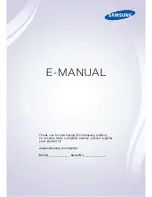
CUC 6460 / 6469
GRUNDIG Service
2 - 9
Schaltungsbeschreibung / Circuit Description
5. Farb-Decoder Sync. 29504-165.67
5.1 Überblick
Der Baustein wird vollständig über den I
2
C-Bus gesteuert und abgegli-
chen. Die wesentlichen Funktionsgruppen des Moduls sind:
- die Video- und Chromasignalverwaltung
- die Chromadekodierung und Bearbeitung
- die Chromasprungversteilerung CTI
- die Y-Signalbearbeitung mit Peaking, Coring und Y- Delay
- die RGB-Signalverwaltung und Einblendung
- die Funktionen zur Bildrohransteuerung inklusive der automati-
schen Dunkelstrommessung für die selbsttätige Bildrohranpassung
Weitere Funktionen sind:
- die dem Kunden zugänglichen veränderlichen Parameter für Hellig-
keit, Kontrast, Farbsättigung, Farbton (bei NTSC), Bildschärfe
(Peaking) und Farbdeckung (Y-Delay).
- die vollständige Steuerung der horizontalen und vertikalen Synchro-
nisation und der zugehörigen Leistungsstufen.
Zu den Schutzfunktionen zählen die Überwachung und Begrenzung:
- des Mittleren und des Spitzenstrahlstromes,
- die Kontrolle der Hochspannung sowie der korrekten Funktion der
Vertikalablenkung.
5.2 Video- und Chromasignalverwaltung
In dieser Baureihe ist keine gesonderte Buchsenplatte vorgesehen.
Stattdessen sind die beiden Peribuchsen rückseitig am Chassis und
die Kamera-Anschlüsse frontseitig entweder auf dem Chassis oder
einem Bedienteil untergebracht. Zusätzlich ist dieses Gerätekonzept
mit einem integrierten SAT-Empfangsmodul ausgestattet (oder zur
Nachrüstung vorgesehen), so daß über diese Quelle zwei zusätzliche
Signale (SAT-FBAS und SAT-Basisband) verwaltet werden müssen.
Die schwarze Peribuchse 1 ("AV1“) ist als VCR/Dekoderbuchse kon-
zipiert, an der als Ausgangssignal lediglich das geräteinterne HF-
Signal (terrestrisch, Kabel oder Satellit) am Ausgang zur Verfügung
steht. Als Eingangssignale können alle geläufigen FBAS- und RGB-
Quellen (Dekoder, VCR, Bildplatte, Videospiele) verarbeitet werden,
wobei die FBAS-Quellen an der orangenen Peribuchse 2 aufgezeich-
net werden können. Die Verwaltung der internen HF-Signale und der
Peribuchse 1 findet auf dem Chassis im IC980, TEA5114A statt,
dessen Ruhestellung so gewählt ist, daß bei nicht bestücktem SAT-
Modul die Verbindungen zwischen Peribuchse 1, terrestrischem
Empfangsteil und Farb-Decoder Sync. Baustein automatisch richtig
stehen. Ist das SAT-Modul bestückt, werden die drei Schalteingänge
des TEA5114A von Open-Kollektor-Ausgängen dieses Moduls kon-
trolliert. Wie Fig. 1 zu entnehmen ist, stehen dem Farb-Decoder Sync.
Baustein an Kontakt 16 und Kontakt 20 zwei geeignet ausgewählte
FBAS-Signale zur Verfügung. Der Benutzer muß im AV-Menü definie-
ren, ob ein VCR oder ein Dekoder angeschlossen wird. Nur im
letzteren Fall werden die internen HF-Signale zum Ausgang freigege-
ben, da bei VCR-Wiedergabe mit Verschlechterung des Signal-/Rausch-
verhältnisses zu rechnen wäre. Der Grund ist in der im allgemeinen
sehr schlechten Übersprechdämpfung zwischen Ein- und Ausgangs-
signal der Verbindungskabel zwischen Fernsehgerät und VCR zu
suchen.
Die orange Peribuchse 2 ("AV2“) ist als VCR-Überspielbuchse konzi-
piert, die in jedem Fall FBAS- wahlweise Y/C-fähig beschaltet ist. Die
getrennte Verarbeitung von Schwarzweiß- und Chromasignal
("SVideo“) wie z.B. Hi8 oder SVHS muß vom Benutzer im AV-Menü
definiert werden. Die beiden Signale Y und C gelangen über Kon-
takt 21 und Kontakt 22 des Farb-Dec. Sync.-Bausteines an den
CMOS-Umschalter MC14053 (IC5020), der wahlweise die Eingangs-
signale der Peribuchse 2 oder der Kameraeingangsbuchse zum
Eingangspaar des IC5040-(6), -(7) durchschaltet. Der FBAS-Ausgang
der Peribuchse 2 wird von einem Zweifach-Verstärker CT5115/16 auf
dem Farb-Decoder Sync. Baustein angesteuert, der von dem per
Software einstellbaren Analogschalterausgang des IC5040-(11) ge-
speist wird. Die Option einer Y/C-Überspielung vom Kameraeingang
zum an Peri 2 angeschlossenen S-VCR ist vorgesehen. Allerdings ist
dazu ein erweiterter Farb-Dec. Sync-Baustein notwendig. Sofern das
Gerät mit dem Modul 29504-165.67 ausgestattet ist, wird auch die
Peribuchse 2 wahlweise zur Peribuchse 1 als RGB-Eingang nutzbar,
da auf diesem Modul der IC5010 (MC14551) als analoger Vierfachum-
schalter bestückt ist. Die Signale G, B, U
Data EXT2
werden über die
Kabelverbindung "FR1“ dem Farb-Dec. Sync-Modul zugeführt.
5. Colour Decoder Sync. 29504-165.67
5.1 Overview
The module is completely controlled and adjusted via the I
2
C-bus. The
important function groups of this module are:
- video and chroma signal routing
- chroma decoding and processing
- chroma transient improvement CTI
- Y-signal processing with Peaking, Coring and Luma Delay
- RGB signal routing and display
- the functions for driving the picture tube including an automatic dark
current measuring facility for automatic adjustment of the picture
tube
Further functions are:
- the parameters for brightness, contrast, colour saturation, tint (with
NTSC), peaking and Y-delay which can be changed by the user.
- complete control of the horizontal and vertical synchronisation and
of the appropriate power stages.
Protective functions are among others the monitoring and limiting:
- of the medium and peak beam current,
- the monitoring of the high tension and of the correct operation of the
vertical deflection.
5.2 Video and Chroma Signal Routing
This series television receivers is not fitted with a separate socket
panel. Instead of it, the two Peri sockets are located on the rear side
of the chassis and the camera connections on the front are either fitted
to the chassis or a keyboard control unit. Additionally, this TV receiver
accommodates (or is designed for later integration of) a SAT module
so that via this source two signals (SAT-CCVS and SAT-Baseband)
must be handled additionally.
The black Peri socket 1 ("AV1“) is designed as a VCR/Decoder socket
at which only the internal HF-signal (terrestrial, cable or satellite) is
available as an output signal. Suitable input signals are all commonly
used CCVS and RGB sources (decoder, VCR, video disc, video
games) with the possibility of recording the CCVS sources at the
orange Peri socket 2. Handling of the internal HF-signals and the Peri
socket 1 is effected on the chassis in IC980, TEA5114A the basic
setting of which has been so designed that, without a SAT module
fitted, the connections of Peri socket 1, terrestrial receiving unit and the
Colour Decoder Sync module are automatically correct. When the SAT
module is inserted, the three switching inputs of the TEA5114A are
controlled by open collector outputs of this module. Figure 1 shows that
two properly selected CCVS signals are available at contact 16 and
contact 20 for the Colour Decoder Sync module. The user has to define
by the AV menu whether a VCR or a decoder will be connected. Only
in the latter case are the internal HF-signals released to be fed out
because on VCR reproduction the signal-to-noise ratio would deterio-
rate. This deterioration is caused by the generally poor crosstalk
attenuation between the input and output signals of the connecting
cables between the television receiver and the VCR.
The orange Peri socket 2 ("AV2“) is designed as a VCR re-recording
socket which can either be connected with a CCVS or optionally a Y/C
source. The separate processing of the black/white signal and the
chroma signal ("SVideo“), e.g. Hi8 or SVHS, must be defined by the
user in the AV menu. The two signals, Y and C, are passed through
contact 21 and contact 22 of the Colour Decoder Sync module to the
CMOS switch MC14053 (IC5020) which connects either the input
signals from der Peri socket 2 or from the camera input socket to the
pair of inputs of IC5040-(6), -(7). The CCVS output of Peri socket 2 is
controlled by a two-stage amplifier CT5115/16 which is located on the
Colour Decoder Sync module and supplied with the output signal from
the software-programmable analog switch IC5040-(11). Retrofitting of
the option for Y/C-re-recording from the camera input to the S-VCR
connected to Peri 2 is possible. In this case however, an expanded
Colour Decoder Sync module is required for this option. When the
television receiver is fitted with the module 29504-165.67, the Peri
socket 2 can optionally also be used as an RGB input, in addition to Peri
1, because the IC5010 (MC14551) is inserted into this module as an
analog quadruple switch. The signals G, B, U
Data EXT2
are passed on to
the Colour Decoder Sync module via the "FR1“ cable connection.
















































